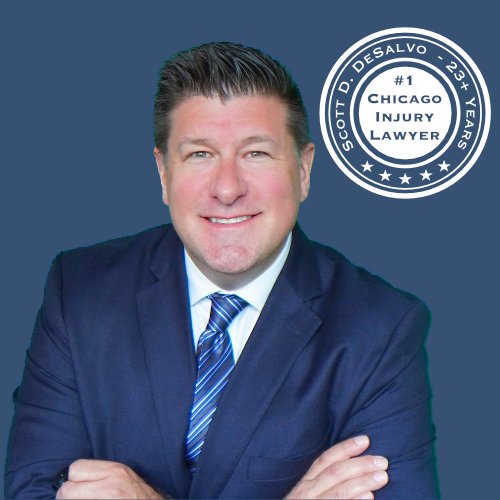Injured By Medical Malpractice?
Chicago's Med Mal Injury Lawyer Gets You PAID FAST.

Free Consult.
Call Any Time.
Free Consult.
Call Any Time.

Examples of Medical Malpractice? Protect yourself and your loved ones by learning the 7 most common examples of malpractice.
Get a second opinion and try to heal and get better. But with medical error as the third-leading cause of death in the United States, it can be hard to feel safe going to your appointments–especially if there’s something seriously wrong. That's why learning examples of medical malpractice can be so valuable.
Your doctor has a responsibility to you as a patient. When they fail, you need help to deal with the consequences.
More than that, you deserve respect as a patient in need of help.
Here are some of the most common examples of medical malpractice and how you can protect yourself if you were a victim of a doctor’s negligence.
Most Common Kinds of Medical Malpractice
Medical malpractice is a subset of common law under personal injury or tort law, designed to protect the plaintiff (you) from future harm and to compensate you for harm caused.
To be considered medical malpractice under the law, the claim must have the following characteristics:
- A violation of a standard of care (your doctor had a responsibility to you as a patient which they failed to uphold)
- An injury that was caused by negligence, which would not have occurred in the absence of negligence
- The injury resulted in significant damages (otherwise, the cost of litigating the case may be greater than the damages and not worth pursuing)
- With that in mind, here are the most common types of medical malpractice.
1. Misdiagnosis
Misdiagnosis, in personal injury cases, can cover a few different things.
Sometimes, your doctor diagnoses you with one condition, when in reality you have a different condition altogether. A common example of this is diagnosing a patient with the flu when in reality they have Lyme disease.
But misdiagnosis can also mean a failure to diagnose, resulting in inaccurate treatment (or no treatment at all).
This is more common than you would think–in fact, it’s more commonly seen in medical malpractice cases than surgical or drug errors.
Commonly misdiagnosed conditions include:
- Heart attack
- Cancer
- Stroke
- Lyme disease
- Thyroid conditions
- Pulmonary embolism
- Celiac disease
Sometimes, these conditions present in unusual ways that wouldn’t make sense unless the doctor was looking for them. Those aren’t examples of medical malpractice.
It is negligence when a doctor fails to diagnose or misdiagnoses something that any doctor with their level of training and available information should have been able to figure out.
2. Delayed Diagnosis
Related to misdiagnosis is delayed diagnosis. In fact, the two often go hand-in-hand.
Delayed diagnosis may occur when a doctor misdiagnoses or fails to diagnose a condition, allowing the condition to progress further in the meantime, whcih is definitely an example of medical malpractice. This can have a detrimental effect on the patient’s health, especially in severe illnesses like cancer.
In order to qualify as a case of negligence in delayed diagnosis, the doctor must have treated the patient less thoroughly than other doctors would have under the same circumstances. For example, the doctor may not have ordered a necessary test that would have made logical sense to pursue.
The trick with this type of personal injury case is proving that your condition would have been materially better if the doctor had begun treatment sooner.
In cancer cases, this can be difficult to prove, as there is a possibility that cancer would have progressed the same way regardless of when treatment started, especially in late-stage cancer treatment.

3. Childbirth Injuries
You spend months preparing for the newest addition to your family. You decorated a nursery, picked out names, and dreamed about what your child would accomplish in the years to come and the person they would grow up to be.
Then, your doctor made a mistake during birth or prenatal care, leading to an injury that will affect your baby for the rest of their life.
One of the most devastating medical malpractice cases for any young family to endure is childbirth injuries. Some of these injuries are minor and can be remedied with treatment, while others have a more severe impact.
Here are some of the most common medical problems associated with medical negligence and childbirth injuries:
- Improper use of forceps during birth
- Surgical errors during a Caesarian section
- Placental abnormalities, such as placental abruption
- Shoulder dystocia, brachial plexus injuries, or other nerve damage during birth
- Oxygen deprivation to the baby
- Hemorrhage of the mother during pregnancy or labor
These injuries place a heavy burden on the parents, both emotional and financial as they try to care for their child.
4. Surgical Errors
Surgical errors are perhaps the most infamous form of medical negligence, even if they aren’t the most common type.
After all, when you undergo extended surgery, you tend to expect that your surgeon is an experienced, capable professional. The prospect of your surgeon making a critical error while you’re on the table is an unfathomable and terrifying notion.
Surgical errors can include a wide variety of possible mistakes, but a few common ones include:
- Using nonsterile surgical instruments
- Failure to control bleeding
- Failure to adequately monitor vital signs during surgery
- Performing an incorrect procedure
- Operating on the wrong body part or wrong patient altogether
- Leaving medical equipment inside a patient
- Damaging nerves, tissues, or organs during surgery
- Unsafe procedures during surgery that result in serious harm to the patient
- Improper care before or after surgery
These errors most often occur when a doctor incorrectly reads a patient chart, neglects to review medical instructions, or clears a patient for the wrong surgery.
Sometimes, these mistakes are minor. But sometimes, they can result in serious consequences for the patient, from lifelong
5. Medication Errors
When you go to the doctor, you expect them to have the knowledge and experience necessary to prescribe you the right medication.
But medication errors are far more common than you might think. If any healthcare provider anywhere in the chain makes a mistake, a patient could be administered 100 times too much (or too little) medication…or the wrong medication entirely.
Medication errors can occur in:
- Choosing a medication (irresponsible or inaccurate prescribing, under or overprescribing, etc.)
- Writing the prescription (writing the wrong prescription or an illegible prescription)
- Manufacturing the medication (wrong strength, wrong components, wrong packaging, etc.)
- Dispensing the medication (wrong drug, wrong strength, wrong formulation, wrong label)
- Taking the medication (wrong dose, wrong duration, wrong frequency, etc.)
- Monitoring therapy on the medication
Medication errors can also include failure to consider a patient’s age or medical history when prescribing a medication or failure to account for allergies when prescribing medication.
This may come from any number of factors, from an irresponsible perception of risk to inadequate knowledge of the patient or the drug to poor communication.
Regardless of the type of error or why it was caused, you as a patient deserve to receive proper treatment by your doctor. If your doctor fails and medication causes you serious harm, you may have a malpractice case.
6. Anesthesia Errors
Surgery is a terrifying prospect for most people. What’s scarier, though, is the fact that dangerous mistakes can happen before you ever enter the operating room.
Anesthesia is a risky part of any surgical operation, which is why your surgeon doesn’t administer the anesthetic. Instead, anesthesia is administered by a doctor specifically trained in how to safely administer and monitor anesthesia.
Prior to a procedure requiring anesthesia, an anesthesiologist will review your medical history, medical record, prior medications, allergies, and requirements for the operation, such as time and the procedure in question.
Anesthesia errors can occur at any point in the process, from negligent preparation to failure to inform the patient of safety procedures before an operation to failure to properly monitor the anesthesia during the operation.
In some ways, anesthesia errors can be more dangerous than surgical errors, as it’s far easier for an anesthesia error to cause serious brain damage. And surgery is risky enough without anesthesia errors.
7. Hospital Infections
A hospital is the safest place to be if you’re seriously injured or dangerously ill. It has the equipment and medical staff at hand to handle almost any medical emergency.
But because of this, hospitals are also full of pathogens, from ordinary people moving throughout the facility to harmful pathogens brought in by ill or injured patients. It shouldn’t be surprising, then, that intensive care units are among the most common places for patients to acquire hospital-associated infections.
In order to qualify as a hospital infection, the infection must occur:
- Up to 48 hours after hospital admission
- Up to three days after discharge
- Up to 30 days after a surgery
- In a medical facility which the patient was admitted to for reasons other than the infection
Hospital infections can be caused by bacterial, viral, or fungal pathogens, all of which come together on a regular basis in a hospital. Common types of hospital infections include:
- Central line-associated bloodstream infections
- Catheter-associated urinary tract infections
- Surgical site infections
- Ventilator-associated pneumonia
Hospital infections can also include things like gastrointestinal infections, soft-tissue infections, lower respiratory tract infections, cardiovascular infections, and infections of the central nervous system, all of which are potential examples of medical malpractice.
Protect Your Rights After Medical Malpractice – We're Here to Help!
Understanding these 7 examples of medical malpractice can help you recognize when negligence may have occurred and protect your rights. If you or a loved one has suffered due to medical errors, The Law Office of Scott D. De Salvo is here to provide guidance and support.
Our experienced team will work tirelessly to help you seek justice and secure the compensation you deserve.
In addition to medical malpractice, we also handle cases involving work injuries, slip and fall accidents, and nursing home neglect. Contact us today for a free consultation and take the first step toward justice.
If you need to speak with an attorney about your case, call 312-500-4500.
Why not get a free consultation?
Here how it goes:
- You call for free (or I can call you).
- I listen to your story.
- I answer your questions & concerns.
- I tell you my plan.
- You can hire me or not hire me, your choice.
- Either way, we end up as friends.
Sound good?



